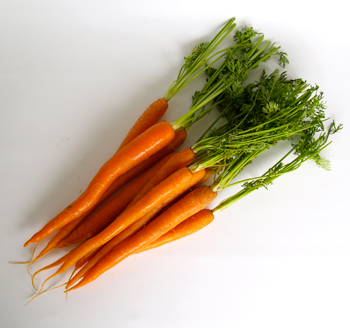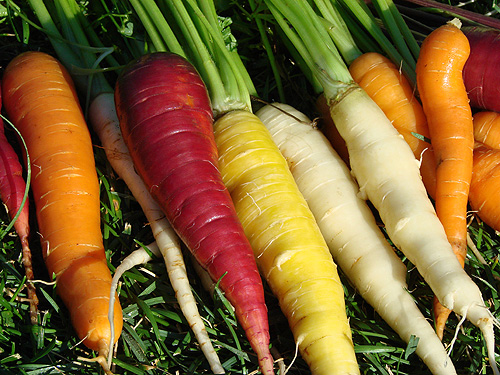
© Denzil Green
Carrots are a root vegetable that can be eaten raw, cooked, or preserved. They grow easily, store well, and are a staple in many of the cuisines of the world.
Big carrots often have tough centres. Carrots that have begun sprouting white roots have been in storage a long time. Big, old carrots — often described as woody — are actually in fact just that. They will have a large amount of ‘lignin’ in them: lignin is the substance that makes wood wood.
If you are going to be grating carrots to be incorporated into a recipe, or making a soup or stew of them, the bagged carrots are fine. Otherwise, if they are to be a feature on their own, try to buy them with the greens still attached, as they should be fresher and sweeter, and try to use in up in a few days. But avoid any on which the top part of the actual carrot is green, as they might be slightly bitter.
Carrots grow best in fluffy, loose, stone-free soil, to give them an easy and clear path in growing downwards. Clay soils need a good amount of peat moss worked in.
The taste of many carrots is best in the fall, after a few fall frosts, which helps to make their taste sweeter and milder.
Cooking Tips
Unless the carrots are very old, there’s no need to peel them for cooking or freezing. Just rinse and scrub them lightly with a vegetable brush: this will preserve the many nutrients just below the skin.
Steam for 7 minutes or boil in salted water for 5 minutes. Pressure cooker, on high: 1 minute for 5 mm (¼″) slices; 4 minutes for 2 ½ cm (1″) chunks.
If you are going to serve carrots raw, cut them into strips and plunk into cold water to firm them up even more. For a bit more interest, put a slice of raw onion in the water. Though if you are contemplating serving your guests a plate of raw veggies accompanied by onion soup mix dip in a bread bowl, you are hereby served fair notice that it might take more than an onion slice in the water to peak anyone’s interest.
If you only have woody carrots to work with, it best not to try to serve them to people only lightly cooked in an Asian fusion style. Your guests might as well be eating chips of orange plywood. These old carrots need a reasonable boil, or better yet, to be made into a lovely carrot mash with cream and butter.
To freeze carrots: wash, remove & discard leafy tops, peel. Boil small whole carrots for 5 minutes, diced or sliced carrot for 2 minutes. Plunge in cold water, drain, package, and freeze.
Substitutes
For the colour and sweetness on a plate, another orange vegetable such as yam, sweet potato, a squash, etc.
Nutrition
Good source of vitamin A. Also contain some protein, carbohydrate, folacin and fibre.
Carrots do not lose very much of their nutritional value during cooking. In fact, some argue that well-cooked carrots are more nutritional than raw ones, as cooking breaks down the lignin in carrots, making more of the nutrients available to our bodies. A 2007 study found that boiled carrots had the highest level of carotenoids available for the body to use in making Vitamin A. Additionally, boiling only destroyed a small amount of the Vitamin C in carrots: 100g of carrots (raw) 31mg Vitamin C. Boiled – 28mg Vitamin C. Steamed – 19mg Vitamin C. [1]
Despite what government health departments told people during the Second World War, there is no relation between eating carrots and seeing better in the dark. The British government invented that myth deliberately to encourage people to fill up more on carrots. There is an eye condition though, called “xerophthalmia”, which can develop owing to lack of Vitamin A, and cause subsequent blindness.
Instead, it’s actually leafy greens that contain lutein and zeaxanthin that do something for your eyes by helping to protect against age-related macular degeneration. Good vegetables for this include spinach and kale.
|
Amount
|
||
| Calories |
23
|
|
| Vitamin C |
31 mg
|
|
Equivalents
1 large carrot = 4 oz / 125 g = 1 cup peeled and grated OR 1 cup, peeled and sliced thinly
1 pound carrots = 450g = 1 average bunch = 6 – 8 medium or 4 very large = 3 cups chopped = 2 ½ cups grated = 1 ⅓ cups cooked and mashed
10 pounds (4.5 kg) carrots, peeled, sliced and canned (aka bottled) yields approximately 15 x 1 US pint (500 ml) jars.
1 cup carrots = ½ cup (heaped) dried carrots = 4 tablespoons powdered carrot (Source: So Easy to Preserve, 2014, page 364.)
Storage Hints
To store fresh bunched carrots, twist off the leafy green tops as they will draw off moisture and nutrients from the carrots. Place in plastic bag and refrigerate for 10 days to 2 weeks (carrots that have come with their tops on may need to be used up sooner than those that came packed tops off in cello bags.) Don’t store in with apples or pears, as the ethylene gas they give off can give carrots a bitter taste.
Freezing: Leave small carrots whole; cut large carrots into thin slices. Blanch in boiling water:
Small, whole carrots: 5 minutes
Diced or sliced: 3 minutes
Plunge into cold water to cool. Then drain well, pack, and freeze.
History Notes
Carrots of many colours
© Michelle Mattern
Carrots are native to Afghanistan. Wild carrots had (and still have) scrawny roots compared to the fat roots obtained from cultivated carrots. Early varieties were red, purple or black. The orange variety of carrots is a modern variety, developed in Holland only in the 1600’s, where it was perhaps popular because it was the colour of the House of Orange.
Carrots were used by both the Romans and Greeks, though they knew them as purple or white vegetables that grew with “forked” roots, unlike today’s single tuber. They would grow them in kitchen gardens. The Romans would eat them raw dressed in oil and vinegar, or cooked. Both the Romans and the Greeks believed carrots had aphrodisiac properties. The Roman Emperor Caligula once forced the whole Roman Senate to eat carrots to inspire them for an orgy. The Romans called them “carota.”
The Romans certainly brought carrots with them to England, but as most food history credits their re-introduction to England with Flemish refugees during the reign of Elizabeth I, it is uncertain what happened to the carrots of England in the intervening period. In any event, the mid 1500’s are when carrots took off again in England. Queen Elizabeth, reputedly presented with some carrots and some butter as a present, sent them off to her kitchen, and a kitchen classic was born: buttered carrots. During the ensuing reign of James I (James VI, pace Scottish readers), its popularity grew to the point where ladies would stick carrot ferns in their hair.
The orange carrot became the popular one not just because of its jaunty colour, but also because purple ones turned brown and mushy when cooked.
Carrots were brought to America, and some escaped into the wild where they became the wildflower now known as Queen Anne’s Lace.
Purple ones are making a bit of a comeback as a specialty vegetable. Thanks to continued development, the colour is attractive, and stays when cooked, and they are very sweet and juicy.
Carrots sold in plastic bags are known in the trade as “cello carrots” because the first carrots be sold packaged, without their green tops attached, were sold in the 1950s wrapped in cellophane.
Literature & Lore
“The only carrots that interest me are the number you get in a diamond.” — Mae West (American actress, 1892 – 1980)
“Large, naked, raw carrots are acceptable as food only to those who live in hutches eagerly awaiting Easter.” — Fran Lebowitz (American writer)
Language Notes
Carrots are called “zanahoria extranjera” (“foreign carrot”) in Ecuador, to distinguish them from the native Arracacha, which is called “zanahoria blanca” (white carrot.)
Sources
[1] Cristiana Miglio, Emma Chiavaro, Attilio Visconti, Vincenzo Fogliano and Nicoletta Pellegrini. Department of Public Health, University of Parma. Effects of Different Cooking Methods on Nutritional and Physicochemical Characteristics of Selected Vegetables. J. Agric. Food Chem., 2008, 56 (1), pp 139–147
Damrosch, Barbara. The beauty of ugly carrots. The Washington Post. 18 May 2011.
Damrosch, Barbara. Get ready for a fall garden. Washington Post. 8 August 2012.
Lambert, Victoria. Can you eat your way to better sight? London: Daily Telegraph. 18 March 2011.


